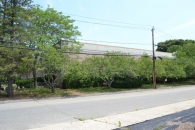Mill Record Clinton
RETURN TO ‘FIND MILLS’Disclaimer: Content for these properties was compiled in 2014-2017 from a variety of sources and is subject to change. Updates are occasionally made under Property Information, however the Connecticut Trust for Historic Preservation (dba Preservation Connecticut) makes no representation or warranty that the information is complete or up-to-date.
- Complex Name (Common)
- Unilever-Ponds facility
- Complex Name (Historic)
-
- Ponds Extract Co.
- Address or Location
- 1 John Street, Clinton
- County
- Middlesex
- Historic Designation
- Associated Mill Community
- n/a
 What can you do at this mill?
What can you do at this mill?
- Historic Information
Companies Associated w/Complex
- Chesebrough Ponds Inc. 1955-1986
- Pond's Extract Co. 1929-1955
- Unilever Ponds 1986-2012
Use (Historic)
Largest Documented Workforce
n/a
Historic Narrative
The Pond’s Extract Company, now a division of the Dutch conglomerate Unilever, has been a major employer in Clinton since 1888. The company began in Utica, New York in 1846, as a partnership between a Native American medicine man of the Oneida tribe and a druggist named Theron T. Pond. Pond, the medicine man, and another partner sold the right to their product to investors and it was first sold as “Pond’s Extract,” in 1857. This product continued to be distilled in New York State until 1872, whereupon the distillery was moved to Chester, Connecticut due to the local availability of wild witch hazel, a critical ingredient. The move to Clinton came in 1888, after a fire destroyed the Chester distillery and the company decided to consolidate the majority of its bottling and manufacturing operations in the former Whittemore Soap Factory on John Street. The Pond’s Extract Company prospered at its new location and in 1906, all machinery still located in the Brooklyn plant was shipped to Clinton by barge. Cold and vanishing creams were soon added to the Pond’s product line and in 1924 the company began its landmark advertising campaign featuring testimonials from prominent American Society women and European royalty. The company’s first concrete building was erected in 1929 and sales continued to be strong even during the depression. The Pond’s Extract Company merged with the Chesebrough Manufacturing Company in 1955, thus forming Chesebrough-Pond’s, Inc. It continued to consolidate its operations in Clinton through the late 1950s and all wooden buildings were eventually replaced with new concrete structures. New brands continued to be added to the company’s product line during the early 1960s and by 1963 the Clinton plant employed over 700 people. In 1986, the company was acquired by Unilever, which in 2011 announced plans to close the Clinton facility at the end of 2012, thus ending Pond’s 124-year presence in the town. quoted from Clinton High Street/John Street NR HD nomination by Heritage Resources 2014
- Architectural Information
Number of Existing Buildings
Three (3) primary blocks.
Dates of Construction
1929, 1935, 1958
Architect
n/a
Builder
n/a
Building Type
Architectural Description
The main and original portion of this building is a three story, poured concrete and steel structure with seven-bay façade, centered entry, slightly projecting entry pavilion, stepped parapet, and flat roof. There are full-height concrete pilasters dividing the façade and south (side) bays, the former consisting of three-story window bays divided by red-brick spandrels. The pilasters at the corner of the buildings and in the pavilion are of a multi-sided pattern with geometric profile, as are three recessed panels in the pavilion’s parapet. Fenestration throughout the building primarily consists of ribbon windows, many with fixed panels and hopper openings. A large concrete block addition is present on the north side of the building. The addition is two stories in height, and is characterized by its unbroken walls with row of upper-story ribbon windows and a flat roof. This building is architecturally significant as a well-preserved example of an Art Deco and International Style manufacturing and office facility. Erected by the Pond’s company in 1929, the original Art Deco section of the building replaced a number of frame structures built by the company and its predecessor, the Whittemore Soap Factory, between c. 1880 and 1928. The three-story wing at the rear of the main block was added by Pond’s in 1935, while the two-story block to the north of the original block was added in a 1958 expansion. quoted from Clinton High Street/John Street NR HD nomination by Heritage Resources 2014
Exterior Material(s)
Structural System(s)
Roof Form
Roof Material
n/a
Power Source
n/a
Condition
n/a
Condition Notes
n/a
- Property Information
-
Specific Location
north side of railroad tracks at west end of Central Avenue
Adjacent To
n/a
Exterior Visible from Public Road?
Yes
Parcel ID / Assessor Record Link
- 44/ 26/ 19 / Link →
Acreage
25.78
Use (Present)
- Sources
-
Form Completed By
n/a
Date
n/a
Bibliography
- Representative View(s)Click on image to view full file








